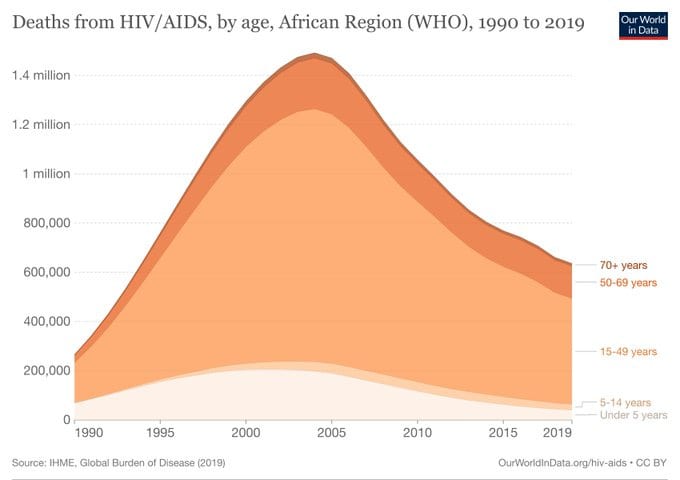This post is crossposted from my Substack. Original here.
Most articles on Trump’s proposed tariffs focus on their economic harm to the United States. They rightly note that protectionism constitutes a sales tax which falls hardest on low-income Americans and actually reduces employment, both in the protected industry and across the economy.
These points are correct and worth making, but they miss the most vulnerable victims of Trump’s tariffs: foreign citizens exporting to America.
Tariffs raise the price of imported goods, and, as a result, Americans switch from buying foreign products to2 domestically produced ones. That means farmers or mechanics living abroad — whose incomes tend to be much lower than those of Americans — lose out on business and see their earnings fall.
Relying on existing economic literature on this topic, I calculate that Trump’s tariffs will increase the number of people living in extreme poverty (<$1.90 a day) by about 2 million. That’s probably a dramatic underestimate but is still large enough that it should figure much more prominently in the policy discussion.
U.S. tariffs increase foreign poverty
There is a sparse, but conclusive, literature examining the effects of developed country protectionism on foreign poverty. Nearly all studies on the topic have found large, negative effects on income earned by those abroad.
Brambilla et al. (2012), for example, finds that U.S. tariffs on Vietnamese fisherman in the early 2000s significantly reduced their household income growth. The opposite is also true: McCaig (2012) concluded that U.S. tariffs cut on Vietnam caused poverty to decrease faster in provinces more exposed to the policy change.
The most useful study for our purposes comes from World Bank economist Kimm Gnangon. In 2021, Gnangnon published a paper estimating whether foreign poverty was affected by non-reciprocal trade preferences (NRTPs) given by QUAD countries (Canada, European Union, Japan, and the United States). Trade preferences allow products to enter into a country duty-free. He found that each percentage point increase in the utilization of these trade preferences reduced the foreign poverty share by 0.016 percent. The effects were larger in the least developed countries.
Quantifying the impact requires assumptions
I use the Gnagnon study to estimate the effect of Trump’s tariffs — not because it’s necessarily the best paper in this literature but because his estimate can most easily be applied here. Tariffs can be thought of as the opposite of reducing a trade preference, i.e. having the opposite sign of Gnangon’s estimates.[1]
But his estimate is just for the share of imports under these special trade preferences, which are a tiny share of these countries’ overall exports, and so this number needs to be scaled up for the effect of across-the-board tariffs. I divide his coefficient by the share of imports covered by trade-preferences versus total imports from these countries (.14).[2] This gives me a final estimate of 0.114 percent.
Another problem is that no one — including even Trump — knows what level of tariffs will actually be implemented under the next administration. Manifold Markets, a prediction market, says there’s a nearly 50% chance that the average weighted tariff will rise to at least 6% in Trump’s first year. Right now, the average weighted tariff is around 2.5%, meaning that the United States taxes about $2.5 dollars for each dollar of imports.
To be conservative, let’s assume the average weighted tariff rises to around 5%. That’s not at all out of the question given that the weighted average tariff peaked at 3.5% under the first Trump administration.
Putting it all together
Now we have all the numbers we need to connect the dots.
If Trump increases the average weighted tariff by 2.5% to a level of 5%, foreign poverty would increase by about 0.285 percentage points. On one hand, that seems like a tiny number.
But that’s about 1.95 million people who will be condemned to poverty as a result of Trump’s tariffs, since about 700 million people currently live on less than a $1.90 a day.[3] And it’s worth repeating that those living abroad are in much more precarious positions than any American worker either helped or hurt by tariffs.
I have read exactly zero articles mentioning this effect. And my number is likely a dramatic underestimate., since I’m not taking any secondary effects on growth or employment into consideration. And just generally there’s a ton of uncertainty around this estimate, so I hope others take this analysis as a starting point.
- ^
This comparison is not strictly correct because allowing a good to be imported duty-free is not the precise opposite of tariffing that good, since one needs to know what the duty level would be in the absence of the NRTP.
- ^
This share is admittedly very speculative. I couldn’t find the total export value of NRTPs-eligible countries compared to their NRTP-covered good. The best proxy comes from a CRS report that has the share of US imports covered by NRTPs versus total imports from these countries. This number is good enough to use, since it’s unlikely the QUAD share differs substantially from the U.S. share.
- ^
There are a ton of problems with just taking his study and running with it. NRTPs only cover developing countries, for example, and his study isn’t just about US imports. But it’s the best we have in forming an estimate.


I'm referring to why it doesn't get brought up by the opposers of Trump tariffs, who clearly do not think that trade is zero sum (unless they somehow think that tariffs benefit foreigners and hurt Americans). The liberal American opposition to tariffs is totally silent on their effects abroad.
Tariffs on manufactured goods are likely incident on manufacturing workers, which is a way in which they can increase poverty, though probably not extreme $1/day poverty. Regardless the general point goes through, that they will reduce the incomes of a generally not-well-off group of people.